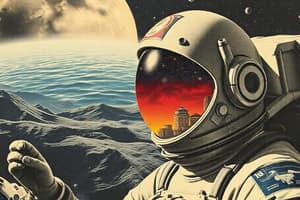Podcast
Questions and Answers
What is the term for very weak gravity in space?
What is the term for very weak gravity in space?
- Antigravity
- Hypergravity
- Microgravity (correct)
- Geostationary
Why can't astronauts drink from a regular glass in space?
Why can't astronauts drink from a regular glass in space?
- Glasses are prohibited on spacecraft
- Liquids evaporate too quickly
- Liquids don't fall into the mouth in space (correct)
- It is against safety regulations
What do astronauts wear outside a spacecraft to prevent floating away?
What do astronauts wear outside a spacecraft to prevent floating away?
- Space suits hooked up to the spacecraft (correct)
- Special magnetic boots
- Tethers connected to nearby objects
- Heavy backpacks
Floating weightlessly within a spacecraft can lead to which of the following?
Floating weightlessly within a spacecraft can lead to which of the following?
What protects those on Earth from most space radiation?
What protects those on Earth from most space radiation?
What is a significant risk for astronauts beyond Low Earth Orbit?
What is a significant risk for astronauts beyond Low Earth Orbit?
For protection, what must an astronaut wear for a spacewalk?
For protection, what must an astronaut wear for a spacewalk?
What is normally sufficient to protect astronauts from harmful rays?
What is normally sufficient to protect astronauts from harmful rays?
In a spacecraft, what must be carefully controlled?
In a spacecraft, what must be carefully controlled?
What is used to keep the temperature stable for astronauts in the International Space Station?
What is used to keep the temperature stable for astronauts in the International Space Station?
What kind of food did astronauts take during the early days of space exploration?
What kind of food did astronauts take during the early days of space exploration?
What do astronauts add to rehydratable food before a meal?
What do astronauts add to rehydratable food before a meal?
How are beverages stored for consumption in space?
How are beverages stored for consumption in space?
What critical substance must astronauts bring with them into space?
What critical substance must astronauts bring with them into space?
What do astronauts do to express frustrations while living in isolation?
What do astronauts do to express frustrations while living in isolation?
To help improve mood, what are researchers looking into for space crews in isolation?
To help improve mood, what are researchers looking into for space crews in isolation?
What can crews tend to that can provide positive behavioral health benefits?
What can crews tend to that can provide positive behavioral health benefits?
How far is Mars from Earth?
How far is Mars from Earth?
What is a key consideration for multi-year trips in space?
What is a key consideration for multi-year trips in space?
What is a precaution astronauts take before their missions to help avoid illness?
What is a precaution astronauts take before their missions to help avoid illness?
Flashcards
Weightlessness/ Microgravity
Weightlessness/ Microgravity
The very weak force of gravity in space
Cosmic Radiation
Cosmic Radiation
Invisible, energetic particles from the sun and galactic cosmic rays
Thermal Control System
Thermal Control System
A system using fluids and radiators to maintain safe temperatures.
Rehydratable Food
Rehydratable Food
Signup and view all the flashcards
Thermostabilized Food
Thermostabilized Food
Signup and view all the flashcards
Oxygen
Oxygen
Signup and view all the flashcards
Quarantine
Quarantine
Signup and view all the flashcards
Spaceflight's Effect on the Human Body
Spaceflight's Effect on the Human Body
Signup and view all the flashcards
Astronaut Teamwork
Astronaut Teamwork
Signup and view all the flashcards
Spacecraft Ecosystem
Spacecraft Ecosystem
Signup and view all the flashcards
Study Notes
- Astronauts face eight hazards during space travel.
- NASA studies these hazards to overcome the challenges of sending humans to the space station, the Moon, Mars, and other destinations.
Weightlessness or Microgravity
- Weight is the attraction between Earth and an object, also known as gravity.
- In space, gravity is very weak, resulting in weightlessness or microgravity.
- Astronauts cannot drink from a glass in space because liquid will not fall into their mouths.
- Anything not fastened inside a spacecraft will float, and astronauts float around too.
- Spacewalking astronauts wear space suits hooked up to the spacecraft.
- Weightlessness can cause dizziness, bone and muscle loss, and vision issues.
Radiation from Space (Cosmic Radiation)
- Earth's magnetic field and atmosphere shield us from most space radiation.
- Everyone on Earth is exposed to low levels of radiation daily.
- Astronauts in space are exposed to varied and increased radiation levels.
- Three main sources contribute to space radiation: particles trapped in Earth's magnetic field, solar energetic particles from the Sun, and galactic cosmic rays.
- Space radiation is invisible, stealthy, and a hazardous aspect of spaceflight.
- Spacecraft walls usually protect astronauts from harmful rays.
- Astronauts wear specially designed spacesuits during spacewalks for protection.
- Beyond Low Earth Orbit, radiation poses a significant risk for radiation sickness, cancer, central nervous system effects, and degenerative diseases.
Temperature and Pressure
- Earth's temperature ranges from 16 to 27 degrees Celsius.
- Space temperatures are not in the right range for humans.
- Spacecraft moving closer to the sun become very hot, while those moving further become very cold.
- Temperature inside a spacecraft must be carefully controlled.
Food
- Early space travelers ate special food squeezed from containers.
- Today, astronauts can bring selected regular food into space due to technology advancements.
Oxygen
- Humans need oxygen to breathe, which is not available in space.
- Astronauts must bring a supply of oxygen with them when traveling to space.
- Longer stays in space require more oxygen.
Isolation & Confinement
- Expedition crews are carefully selected, trained, and supported for 6-12 month space station missions.
- Moon or Mars mission crews undergo more intensive assessment due to longer travel in isolated environments.
- NASA studies people in isolated environments.
- Astronauts keep journals to express frustrations, providing researchers with insights into behavioral problems.
- Virtual reality is being researched to simulate relaxing environments, improving mood.
- Relevant activities, like language or medical skill learning, can ward off depression and boost morale.
- Space gardens can provide behavioral health benefits, fresh food, and air purification.
Distance from Earth
- The space station orbits 240 miles above Earth.
- The Moon is 1,000 times farther than the space station.
- Mars averages 140 million miles from Earth, with a communication delay of up to 20 minutes one-way.
- Mars astronauts must solve problems independently due to communication delays.
- Food, medicine, equipment, and medical supplies need to be packed for multi-year trips without resupply.
- Medical training prepares astronauts to respond to health problems.
- Astronauts learn to produce intravenous (IV) solutions using onboard equipment and purified water.
- Crew members perform ultrasound scans on each other to monitor organ health.
- Diagnostic testing and treatment protocols are in place for crew members who become sick.
- NASA studies and improves food formulation, processing, packaging, and preservation systems.
- Space-resilient medications and packaging systems are essential for long-duration missions.
Hostile/Closed Environments
- The ecosystem inside spacecraft significantly impacts astronaut life.
- Microbes can change in space, and microorganisms transfer more easily between people in closed habitats.
- Air quality is monitored in the space station to ensure a breathable atmosphere.
- Thermal Control Systems maintain temperatures.
- Astronauts receive flu shots and quarantine before missions to prevent illness.
- Crews change air filters, clean surfaces, and treat water to prevent contamination-related illnesses.
- Living and working environments are planned for comfort and efficiency.
- New LED lighting systems onboard simulate natural Earth-like lighting.
How Space Affects the Human Body
- Weaker gravity on the ISS or spacecraft affects the human body significantly.
- "Space sickness," including headaches, nausea, and vomiting, is common.
- Radiation doses are higher, increasing the risk of cataracts, DNA damage, and cancer.
- Muscles lose mass and strength.
- Bones lose density and strength; astronauts can lose up to 1.5% of their bone mass each month, compared to the typical 1% yearly loss for adults over 50.
Studying That Suits You
Use AI to generate personalized quizzes and flashcards to suit your learning preferences.



